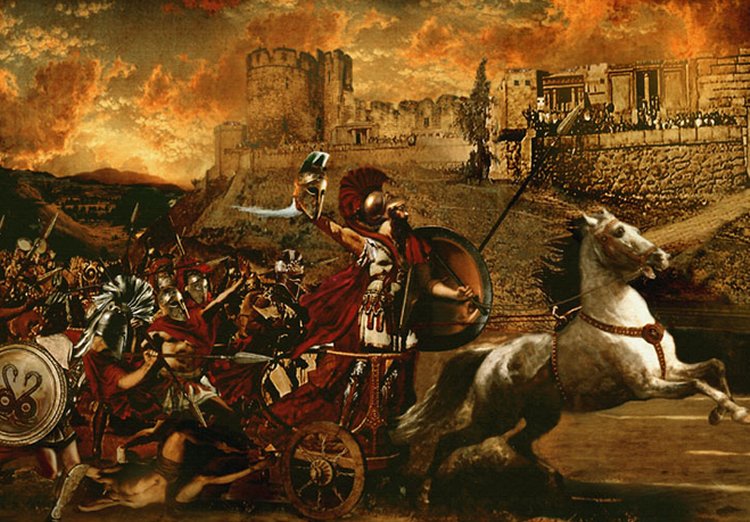Achilles – Son Of King Peleus And Leader Of The Nereids
A. Sutherland - AncientPages.com - The epic poem, The Iliad, was written by Homer sometime in the 8th century BC. It recounts some of the most important events of the final weeks of the Trojan War and the Greek siege of the city of Troy.
Achilles Triumphant (The Iliad) illustration by Howard David Johnson.
One of the central figures of the epic is Achilles, who traveled to Troy to bring Helen back to her husband, King Menelaus of Sparta, Agamemnon's younger brother. Achilles was the son of King Peleus of the Myrmidons and Thetis, the leader of the 50 Nereids.
Both Zeus and Poseidon desired the beautiful sea goddess but were warned by the Titan Prometheus that any male child born to her would become more significant than his father. As such, both the brothers ceased pursuing her and convinced Peleus to marry her instead.
When Achilles was born, Thetis wanted to gift him immortality. She took him to the Underworld and, holding him by the ankle, dipped him in the waters of the River Styx. However, she was unaware that the only dead spot on his entire body was the one ankle she had held when she submerged him in the river.
Another version tells that to make Achilles immortal, she smothered his body with ambrosia and then placed him on top of a fire to burn away the mortal part of his body. As she was doing this, however, Peleus interrupted her, and enraged, she left them both with the process unfinished.
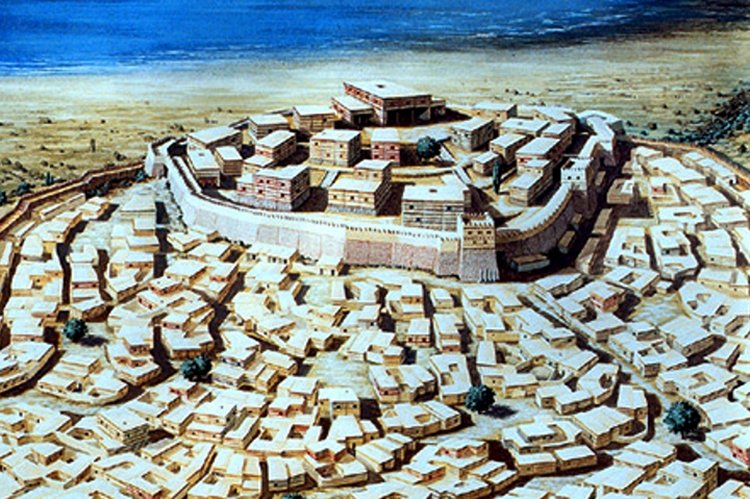 Reconstruction of Troy VIh/VIi (Wilusa of the Hittite text. Credits: Copyright by Christoph Haussner Munich
Reconstruction of Troy VIh/VIi (Wilusa of the Hittite text. Credits: Copyright by Christoph Haussner Munich
When the Trojan War began, Achilles was given the command of fifty ships, each containing 50 men. He engaged the services of five commanders-in-chief - Menesthius, Eudorus, Peisander, Phoenix, and Alcimedon. After they set sail for Troy, they accidentally landed in Mysia, where King Telephus ruled.
Telephus went to Achilles and was healed in exchange for directions to Troy.
A fight broke out with Achilles wounding Telephus, but the injury wouldn't heal, so Telephus consulted an oracle. He was told that only the person who caused the wound would be able to cure it.
The Iliad begins the narrative of the Trojan War when King Agamemnon attained a woman named Chryseis and enslaved her. Her father was a priest of the god Apollo, and she pleaded with him to aid his cause. Upon hearing this, Apollo sends a plague to curse the Greeks. Calchas informs Agamemnon of what caused this curse.
Reluctantly, Agamemnon agrees to give up Chryseis but only on the condition that Achilles hands his woman Briseis over to him. Achilles is outraged at the lack of respect and withdraws from the battle.
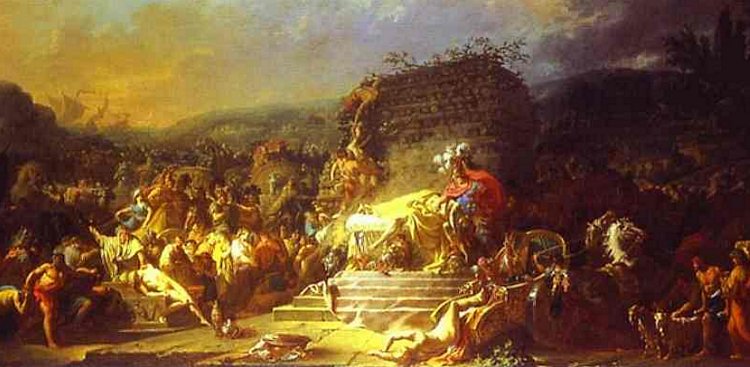 The Funeral of Patroclus - Jacques-Louis David
The Funeral of Patroclus - Jacques-Louis David
He visits with his mother, Thetis, and convinces her to ask Zeus to aid the Trojans so that he may demonstrate his worth in action once more. After this, the Trojans can push the Greeks back to shore.
Here, Patroclus, the friend of Achilles, puts on his armor without him knowing and commands the Myrmidons in a battle against the Trojans. However, he is slain by Hector, one of King Priam's sons. Achilles is enraged at Patroculus's death; he rejoins the Greeks on the battlefield and kills Hector. Subsequently, he ties Hector's body to his chariot throughout the funeral games held for his friend. As he lies about dying, Hector tells of how Achilles will die.
Hector's brother, Paris, shoots at the Greek hero, and the poisoned arrow lands in Achilles' one dead spot – his ankle.
According to other accounts, Apollo guided the arrow toward the Achilles heel. After Troy had fallen to the Greeks, his body was cremated and merged with the ashes of Patroclus.
Written by – A. Sutherland AncientPages.com Staff Writer
Updated on October 18, 2022
Copyright © AncientPages.com All rights reserved. This material may not be published, broadcast, rewritten or redistributed in whole or part without the express written permission of AncientPages.com
Expand for referencesSpara
Spara
More From Ancient Pages
-
 8000-Year-Old Prehistoric Çatalhöyük: Residents Were Buried In Their Homes
Archaeology | May 1, 2020
8000-Year-Old Prehistoric Çatalhöyük: Residents Were Buried In Their Homes
Archaeology | May 1, 2020 -
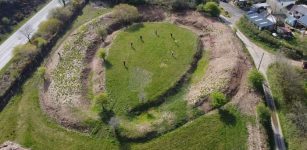 Huge Ancient Underground Stone Circle Discovered Inside Cornwall Neolithic Henge
Archaeology | May 21, 2022
Huge Ancient Underground Stone Circle Discovered Inside Cornwall Neolithic Henge
Archaeology | May 21, 2022 -
 Why We Celebrate Saint Lucy’s Day – The Bringer Of Light And Patron Of The Blind
Christmas Traditions | Dec 13, 2024
Why We Celebrate Saint Lucy’s Day – The Bringer Of Light And Patron Of The Blind
Christmas Traditions | Dec 13, 2024 -
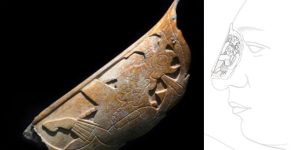 Ancient Maya Nose Ornament Made Of Human Bone Discovered In Palenque
Archaeology | Sep 24, 2023
Ancient Maya Nose Ornament Made Of Human Bone Discovered In Palenque
Archaeology | Sep 24, 2023 -
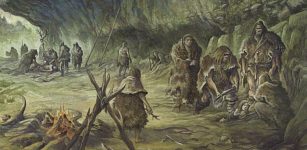 Neanderthals Buried Their Dead – New Evidence
Archaeology | Dec 10, 2020
Neanderthals Buried Their Dead – New Evidence
Archaeology | Dec 10, 2020 -
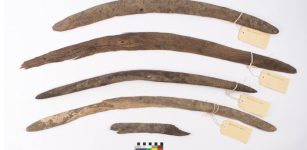 Rare Ancient Boomerang Collection Sheds New Light On Australia’s Past
Archaeology | Nov 4, 2021
Rare Ancient Boomerang Collection Sheds New Light On Australia’s Past
Archaeology | Nov 4, 2021 -
 Day Of The Dead: From Aztec Goddess Worship To Modern Mexican Celebration
Ancient Traditions And Customs | Oct 30, 2019
Day Of The Dead: From Aztec Goddess Worship To Modern Mexican Celebration
Ancient Traditions And Customs | Oct 30, 2019 -
 Hidden Connection Between The Zodiac, Ancient Egypt, Freemasonry And Christianity
Ancient Mysteries | Aug 14, 2018
Hidden Connection Between The Zodiac, Ancient Egypt, Freemasonry And Christianity
Ancient Mysteries | Aug 14, 2018 -
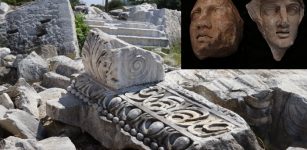 Once Impressive Temple Of Hadrian In City Of Cyzicus Will Be Restored Soon
Archaeology | Sep 7, 2020
Once Impressive Temple Of Hadrian In City Of Cyzicus Will Be Restored Soon
Archaeology | Sep 7, 2020 -
 10 Remarkable Ancient Indian Sages Familiar With Advanced Technology And Science Long Before Modern Era
Featured Stories | Oct 19, 2015
10 Remarkable Ancient Indian Sages Familiar With Advanced Technology And Science Long Before Modern Era
Featured Stories | Oct 19, 2015 -
 Mystery Of The Bizarre Dark Figure Vanishing Into Thin Air Seen By Hotel Guests And Staff
Featured Stories | Mar 15, 2019
Mystery Of The Bizarre Dark Figure Vanishing Into Thin Air Seen By Hotel Guests And Staff
Featured Stories | Mar 15, 2019 -
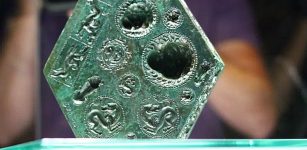 Unique 2,000-Year-Old Hexagonal-Shaped Bronze Matrix Of Sarmizegetusa Regia, Romania
Artifacts | Jan 7, 2016
Unique 2,000-Year-Old Hexagonal-Shaped Bronze Matrix Of Sarmizegetusa Regia, Romania
Artifacts | Jan 7, 2016 -
 On This Day In History: Solar Storm Known As The Carrington Event Took Place – On August 28, 1859
News | Aug 28, 2016
On This Day In History: Solar Storm Known As The Carrington Event Took Place – On August 28, 1859
News | Aug 28, 2016 -
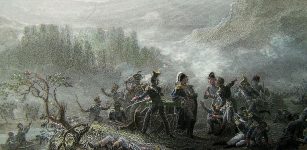 On This Day In History: Battle Of Durnstein Was Fought On The River Danube – On Nov 11, 1805
History | Nov 11, 2016
On This Day In History: Battle Of Durnstein Was Fought On The River Danube – On Nov 11, 1805
History | Nov 11, 2016 -
 Earth’s First Animals Had Particular Taste In Real Estate
Evolution | May 10, 2023
Earth’s First Animals Had Particular Taste In Real Estate
Evolution | May 10, 2023 -
 Long History Records Of Medicine In Mesopotamia And Sumer
Civilizations | Nov 20, 2017
Long History Records Of Medicine In Mesopotamia And Sumer
Civilizations | Nov 20, 2017 -
 Vali – Son Of Odin, Who Avenged Death Of Balder And Survived Ragnarok
Featured Stories | Aug 29, 2019
Vali – Son Of Odin, Who Avenged Death Of Balder And Survived Ragnarok
Featured Stories | Aug 29, 2019 -
 Terahertz Imaging Reveals Hidden Inscription On Early Modern Funerary Cross
Archaeology | Apr 26, 2022
Terahertz Imaging Reveals Hidden Inscription On Early Modern Funerary Cross
Archaeology | Apr 26, 2022 -
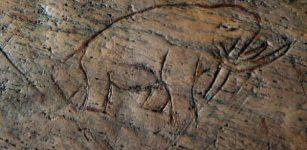 Controversial Study Of Ancient DNA Could Re-Write History Of South Florida And Prove Humans And Huge Prehistoric Animals Co-Existed
Archaeology | Sep 23, 2014
Controversial Study Of Ancient DNA Could Re-Write History Of South Florida And Prove Humans And Huge Prehistoric Animals Co-Existed
Archaeology | Sep 23, 2014 -
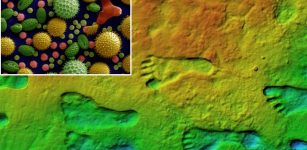 Humans Got To America 7,000 Years Earlier Than Thought – New Research Confirms
Archaeology | Oct 9, 2023
Humans Got To America 7,000 Years Earlier Than Thought – New Research Confirms
Archaeology | Oct 9, 2023

